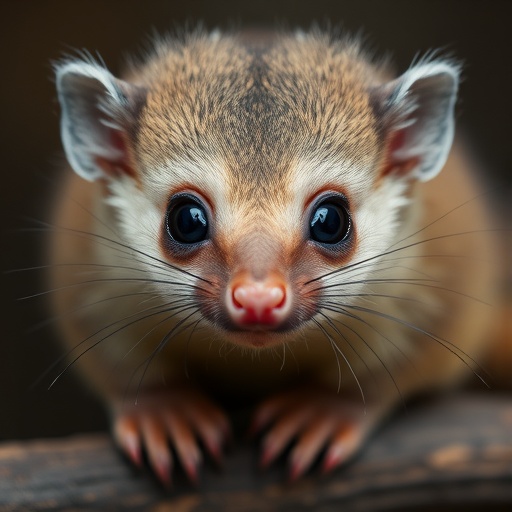In Australia’s harsh desert landscapes and unique ecosystems, some of the continent’s rarest marsupials reveal a remarkable genetic tale behind their unusual coat colors. Groundbreaking research from La Trobe University has uncovered that these distinctive color morphs are not simply random quirks but the direct consequence of mutations in critical pigment-related genes. This revelation sheds new light on the intricate genetic mechanisms driving fur coloration and hints at convergent evolutionary strategies among marsupial species that have long fascinated biologists.
Among these rare marsupials, the desert-dwelling marsupial mole and the black-coated variant of the endangered eastern quoll stand out due to their distinctive pigmentation. While abnormal coloration such as melanism (dark pigmentation) and xanthism (excessive yellow pigmentation) have traditionally been regarded as detrimental mutations that impair survival and camouflage, this study challenges that view. The researchers found that, rather than being sporadic anomalies, these color morphs are consistently observed, and, in some cases, are endemic characteristics of entire species.
Central to the gene pigmentation pathway are two critical genes: Agouti Signalling Protein (ASIP) and Melanocortin 1 Receptor (MC1R). Normally, the interplay between these genes regulates the balance between two primary pigments in mammalian fur—eumelanin, which produces darker black or brown coloration, and pheomelanin, responsible for lighter red to yellow hues. Disruptions to this finely tuned molecular switch can thus lead to pronounced and uniform color changes across the animal’s coat.
In eastern quolls exhibiting the rare black morph, the investigation revealed a deletion in the DNA segment coding for the ASIP gene. This gene typically functions by inhibiting MC1R activity to promote the production of pheomelanin. When ASIP is disabled by such missing DNA sequences, the pathway skews exclusively toward eumelanin production, resulting in the striking black coat. This loss-of-function mutation fundamentally alters the quolls’ pigmentation pathway and provides a vivid example of how single-gene deletions can drive visible phenotypic variation.
What heightens the intrigue is the discovery of a nearly identical genetic deletion in the Tasmanian devil, a closely related species that exhibits a similarly dark coat coloration. Through comparative genomic analyses, the researchers demonstrated that although the deletion in ASIP occurred independently in these two species, the resultant color change converged through parallel evolutionary mechanisms. This phenomenon, known as convergent evolution, underscores how different species can evolve comparable traits through analogous genetic modifications in response to similar selective pressures.
The investigation extended beyond quolls and devils, delving into the elusive and seldom-seen marsupial mole. Native to Australia’s deep deserts, these ‘sand swimmers’ are almost unique among mammals for their xanthic, or light yellow, fur color. Using a recently assembled genome of the marsupial mole, scientists identified a truncating mutation in the MC1R gene. This gene, which typically stimulates the production of dark eumelanin, is rendered nonfunctional due to a premature stop codon mutation, causing the animals to produce very little or no eumelanin and thus adopt their pale yellow coats.
The dual disruption of either ASIP or MC1R effectively tips the pigment production “switch” entirely in favor of one pigment type, eliminating the usual banded hair patterns that create greys and browns in most mammalian pelage. The ASIP gene normally inhibits MC1R, periodically shutting off eumelanin production, which results in a mixture of lighter and darker pigments along each hair shaft. When either gene is “broken,” this balance collapses. This molecular explanation accounts for the persistence of extreme color morphs in these marsupials and highlights the critical role that single-gene mutations play in defining vivid phenotypic traits.
The broader evolutionary implications of such mutations are still unfolding. While coat color variations are traditionally understood as either adaptive camouflage or non-adaptive genetic drift, the study’s lead author, Dr. Charles Feigin, points out that the impacts of these “broken genes” could be complex. They may influence more than just an animal’s appearance, potentially affecting predator-prey interactions, social signaling, or thermal regulation, but clarifying these effects requires further ecological and behavioral research.
Interestingly, these findings suggest that what were once assumed to be isolated pigmentation disorders could instead represent an underappreciated aspect of marsupial evolution and adaptation. The recurring theme of loss-of-function mutations in pigment genes across disparate marsupial lineages points to distinct evolutionary pathways converging on similar phenotypic outcomes. These insights could have significant repercussions for the understanding of mammalian pigmentation and the genetic basis of adaptive morphological traits more broadly.
The continued advancements in marsupial genomic assemblies, like the recent one for the marsupial mole, are proving pivotal in unraveling these genetic narratives. By providing comprehensive maps of the genetic architecture underlying pigmentation, such genomic resources allow for targeted exploration of how gene function modulates phenotype and how such traits evolve in isolated and extreme environments. The marsupial example thus serves as a compelling case study for evolutionary developmental biology.
This research was published in the journal Biology Letters and funded in part by the Wild Genomes initiative, reflecting the growing momentum in wildlife genomics to decode the mechanisms underpinning biodiversity. The study’s technical approach combined data-driven statistical genetic analyses with comparative genomics, highlighting how interdisciplinary techniques can illuminate fundamental biological questions about evolution and adaptation.
With the growing accessibility of genetic sequencing and analytical tools, future studies are poised to explore how mutation-driven variation in pigmentation genes might link to wider physiological and ecological traits. For now, the remarkable discoveries in these uniquely colored Australian marsupials affirm the centrality of “broken” pigment genes in shaping nature’s palette and open new chapters in our understanding of convergent evolutionary processes.
Subject of Research: Animals
Article Title: Loss-of-function mutations in ASIP and MC1R are associated with coat colour variation in marsupials
News Publication Date: 22-Oct-2025
Web References: https://royalsocietypublishing.org/doi/10.1098/rsbl.2025.0302
References: DOI 10.1098/rsbl.2025.0302
Image Credits: Dr Charles Feigin
Keywords: Evolutionary biology, Evolutionary genetics




